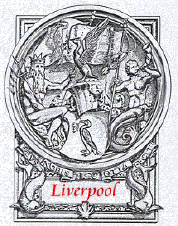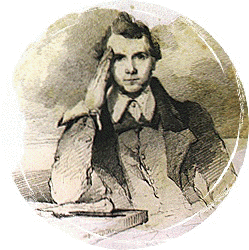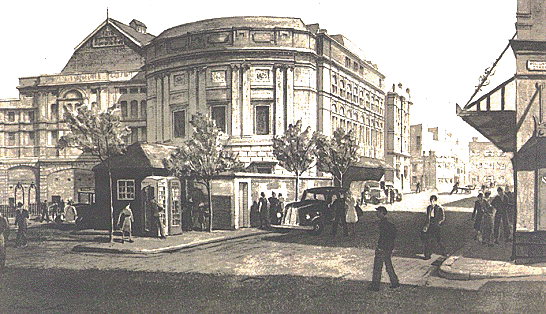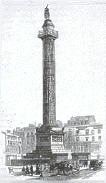 |
 |
 |
The Golden
Age
Victorian Heritage
Liverpool's
Birthday
Liverpool's Charter
was granted in 1207 which makes the year 2007 momentous in marking the
city's 800th birthday.  Liverpool is unique in many ways but one of them
that is rarely remarked upon is that while other cities retain their origins and
evolve slowly so that change is imperceptible, this city is not like that at
all. A feature of Liverpool is that it has always been subject to dramatic
and tumultuous changes, blackboards vigorously wiped clean and a whole new plan
put into place. As a result, there are very few reminders of Liverpool's
past, with the oldest buildings in the city centre of comparatively recent
vintage; the Town Hall was built in 1745 and the Bluecoat building just a few
years earlier. Why this should be so is not always clear but it has to be
said that successive civic blunders from as far back as the demolition of
Liverpool Castle right up to the loss of the Cavern and all points in-between,
have been a major reason.
Liverpool is unique in many ways but one of them
that is rarely remarked upon is that while other cities retain their origins and
evolve slowly so that change is imperceptible, this city is not like that at
all. A feature of Liverpool is that it has always been subject to dramatic
and tumultuous changes, blackboards vigorously wiped clean and a whole new plan
put into place. As a result, there are very few reminders of Liverpool's
past, with the oldest buildings in the city centre of comparatively recent
vintage; the Town Hall was built in 1745 and the Bluecoat building just a few
years earlier. Why this should be so is not always clear but it has to be
said that successive civic blunders from as far back as the demolition of
Liverpool Castle right up to the loss of the Cavern and all points in-between,
have been a major reason.
But it has not been the only reason; the 1940 to 1942 Blitz changed the face of
the city dramatically, levelling whole areas and leaving the only recourse to
clear away and start again. It was the perfect opportunity to create a
city like no other, to supplement the splendid Victorian heritage already in
place and build on a grand scale toward a city that would last centuries.
It was simply an unhappy coincidence that the time to rebuild came at a time
when European and British architecture had reached an absolute nadir and a
golden opportunity was dashed upon the concrete rocks of 60's featureless
nonentities. Not just in Liverpool but all over the country, 60's
architecture has become synonymous with concrete and glass monstrosities with no
aesthetic values whatsoever and where even the purely functional didn't
function. The architecture of the 1960's is universally detested and the
wonder is that the people who spawned such mediocrity had the temerity to place
it alongside the classical lines of Victorian buildings and in some cases to
obscure them.
City of Culture
The year
following this great event, Liverpool becomes European Capital of Culture and
the city is going through one of the most frenetic and wholesale alterations in
its history. Much of the building work is being carried out under wraps
and it remain to be seen if the lessons of the past have been absorbed. It
is fair to say that there will be nothing whatsoever to stand comparison with
the likes of St. Georges Hall or the Albert Dock and perhaps a little unfair to
make comparisons but in any analysis of what is excellent in Liverpool the
needle invariably swings to the Victorian era and in many ways this was
Liverpool's Golden Age. To be quite clear upon this subject, The Golden
Age in this context refers to the architecture, art and commerce of the city and
if the voices from the past could be heard, there would be a vast majority
living in grinding poverty or escaping the Irish Famine who would call this
description laughable. There would also be a great number who would state
that it was built upon the Slave Trade and although it was abolished in 1807 in
England, it's no coincidence that the Golden Age followed on the heels of the
wealth accrued from this barbaric industry.
It is a matter of conjecture and amazement that not one building of any note has been erected in
the city, built in the local sandstone, since the last century. The
Victorians had no J.C.B.'s, no cranes, no machinery at all ----and yet they
built on a grand scale, iconic buildings which will last centuries using levers
and pulleys which would have been quite familiar to the builders of ancient
Rome. The
year 2000 signals the end of the sandstone era and even the Three Graces built
in 1906 were built of limestone----although it could be said that they arose
from the last gasps from the latent energy of the Victorian era.
All these things are what makes the Herdman Collection so valuable as a
chronicle of Liverpool throughout the 19th century and as such it is of
incalculable worth.
The Herdman Collection
" I
have done more for art in England than any man living"
were William Gawin Herdman's words to Lord Derby in 1864
and while it may have been exaggerated in respect of England, it was certainly
true in respect to Liverpool. The Herdman family are to
Liverpool what Canaletto is to Venice.
William Gawin Herdman was born in 1805 and his illustrious career spanned much
of the Victorian era. However he sketched from an early age and was
perspicacious enough even at the age of 12 to draw many buildings in the city
which were from previous eras, many of which were demolished in his own
lifetime. He continued in later life by painting old sketches which are
lost to us today.
They had names to conjure with in those days and in 1827, William Gawin married
Elizabeth Darley Innes, and just as he was prolific in painting, Elizabeth was
no less prolific in producing children. Over the years, they had no less
than 16 offspring ---only 6 of them outlived their father. The family
lived in London Road, Russell St, Clarence St and St. Domingo Vale and several
of the children inherited their father's gift ---William, Patricia, Bertha
Jeanette and Stanley were all artists in their own right. William, who
in the finest traditions of starving artists lived in a court in Hygeia St,
actually has more paintings in the collection than his father. While William Gawin Herdman was undoubtedly the doyen of the family,
there's no doubt that several of the others also valuable work and such is the similarity that it is difficult to distinguish who
painted what. William Patrick was by all accounts an accomplished
botanical artist specialising in painting ferns but his work has become lost in
the mists of time and plays no part in the collection----perhaps the day will
come when they will be rediscovered. As the collection numbers over 1400 works of art of
unvarying quality only a purist would attempt to distinguish one from the other
and it's certain that the family would take pride in the knowledge that it is
now known as the Herdman Collection.
When Herdman was painting, like so many before him he needed a patron and a
certain William Bennett who owned a business in the city bought many of the
pictures. On his death, the paintings went to auction and became
scattered. How it came back together again is a detective story in its own
right and only the Machievellian dealings of the Liverpool librarians over many
years saw it housed as a whole within the precincts of Picton Library. It
is to the great credit of James Picton and the librarians that they recognized
the worth of the paintings and spent so much time and effort in bringing them
together in the Picton Library ---even as late as 1945, the library was buying
up scattered portions of the collection which had found their way into other
hands.
Herdman died in 1882 and was buried in Anfield Cemetery but his legacy lives on.
The few examples of his work shown here are just a fraction of his work.
This painting of the
Canada dock shows a castellated building built by
Jesse Hartley in 1859 and
reminiscent of his faux-medieval gates to the Albert Dock entrance. The building housed the
machinery which drove the hydraulics which operated the dock gates.
The Canada dock was so-called because it was the site of the ships landing
timber from Canada whence they would be taken by horse to be transported to
wherever they were bound.
Across the road over the Dominion Pub is a ship's figurehead of a Canadian
lumberjack. The pub today is up for sale and it is quite possible if
the building is converted into some other function that the Lumberjack will be
lost in the construction work as having no value.
The dock today is cold and bleak with cormorants fishing in the water and
massive machines loading scrap metal onto ships.
The building on the right is adjacent to the one in the
Canada dock and very similar apart from having a clock on each of the
sides. Again, it is the work of Jesse Hartley who could never resist a
touch of whimsy in all of his designs.
Just opposite are the monolithic
tobacco warehouses built in the 1850's and the largest in Europe.
Presently
mouldering beside the dock, they will no doubt be turned into luxury apartments
in the near future.
Pure Theatre
Williamson Square has
been a place of entertainment from the 15th century when it was known as
Williamson's Field and was a gathering place for troupes of itinerant jugglers,
troubadours and orators. There were regular complaints to the City Fathers
that the entertainment was attracting an unruly element and causing disorderly
behaviour ---- a situation which persisted for many years and even up to and
beyond the building of the first theatre.
The original Theatre Royal was part of Williamson Square from 1771 but
theatre-goers complained not only of the mud at the entrance but the fights and
loutish behaviour of sailors and prostitutes infesting the building and spoiling
the entertainment on show ----evidently theatre-going in those days was less
than the elegant pastime it is credited with being today. In 1802, the building
was demolished and in its place the distinctive curved lines of the New Theatre
Royal graced Williamson Square attracting thespians from near and far.
The
great Shakespearean actor Edmund Kean appeared on-stage in 1815 and two years
later the world famous clown Grimaldi was the star. Grimaldi's clowning
turned to tragedy when his son was killed in a brawl outside the theatre and it
was apparent that the square's reputation for violence and disorder had never
gone away. Some years later, a mediocre actor named George Cook is
remembered more for his acidic remark in response to being barracked ---a
riposte which was all the more cutting for having more than a ring of truth
about it. The actors words have remained memorable far more than any of
his performances. Dripping with venom, Cook's reply to a stunned audience
concluded with the words " Every brick in your
dirty town is cemented with a Negro's blood !! "

A very early performance of a play with the distinctive title Captain
Driver in Oroonoka was banned because it was said to reflect the
conduct of certain Liverpool slave merchants -------this was around the time of the
Abolition Bill which was causing much ferment in the town and tempers were high
mainly from shipping merchants who stood to lose their very lucrative trade
transporting black africans across the Atlantic.
During
Victorian times, Dickens, Irving, Paganini and even Blondin, the famed
tight-rope walker, all appeared at the
New Theatre Royal along with a certain player of the era called Junius Brutus
Booth who was famous for his serious acting roles.
Junius Brutus's son, John Wilkes
Booth, later carried on the family tradition for the theatre by assassinating
President Lincoln during a performance of Our American Cousins and is remembered
for that single role far more than his father's whole career. Booth
bluffed his way into Lincoln's box in Ford's Theatre, Washington, shooting
the great man down, only five days after his momentous victory over the
Confederate army, finalised by Lee's surrender. The deranged assassin then
leapt onto the stage brandishing a dagger while exclaiming Brutus's words when
he stabbed Caesar "Sic semper tyrannis" ---"thus
die all tyrants". Booth was cornered ten days later and shot down in
his turn.
In 1896, The New Theatre Royal closed down and the building came into the
possession of a different Company altogether, the Union Cold Storage
Company which ingeniously converted the old building into a cold storage unit
where for many years massive slabs of ice could be seen by anyone who cared to
peer into the Arctic- cold rooms. The ice-house in its turn passed into
history when the graceful lines of the old theatre were uncaringly torn down
with the workmen complaining of the dust from the clouds of charcoal which had
lined the walls to retain the cold.
The Liverpool F.C. outlet now stands on the site, housed in one of those
ephemeral 70's buildings of glass and steel which is purely functional and has
nothing whatsoever of the character of the building it has superceded. It
contrasts unfavourably with the old buildings still extant in the square.
Herdman's painting of the New Theatre Royal was completed
in 1859 and for some reason omits the Star Tavern which would have been on the
right-hand side of the canvas. Herdman rarely missed painting anything of
worth but on this occasion his omission could not be rectified when in 1866 the
Star Tavern became the Star Music Hall. For the following twenty years or
so, the Star vied with the New Theatre Royal but closed down in 1898, two years
after the closure of the New Theatre Royal, leaving the square unusually quiet
and without purpose.
Fortunately, the Star was renovated and re-opened in
1911 as the Playhouse Theatre which today overlooks the square, quietly
resisting the encroachment of tasteless tat which passes for architecture these
days. There has been a modern foyer tacked on at the side which is
deliberately circular in shape in recognition of the old Theatre Royal.
The Playhouse has had an illustrious history
and the famous names that have played there are legion. It is the oldest
repertory theatre in the country.
Looking down Chapel St
towards the river is the church of Our Lady and St. Nicholas with the Hargreaves
building in the foreground. The building is circa.1860 and the carved
heads of explorers around the building tell that it was originally a shipping
office. This view is very little changed today.
The picture of Chapel St shown here is from the same angle. St Nicholas'
Church is quite recognisable but the buildings in the foreground are the prior
to the Hargreaves building. This picture is around 1829 so the new
steeple is in in place on top of the church.
This picture shows James St looking up from the river. The church at the
top of the slope is St Georges church and stood on the exact site where
Liverpool Castle once stood. The massive monument to Queen Victoria now
stands on this site.
The Queen Elizabeth 11 Law Courts stand in the background and the circular lines
on the paving stones delineate the walls of the old castle.
St.Georges
church as it was in 1829.
This view of
Dale
St is little changed today. On the left hand side the corner of the Town
Hall is visible and the small street
leads to Exchange Flags.
Exchange Flags was so named because this was
where merchants and ship owners gathered to exchange bills of lading. The
magnificent statue of the death of Nelson stands in the centre. The Flags
and the statue are impressive and the wonder is that Herdman chose not to paint
them. The statue of Nelson is often mistakenly attributed to be a monument
to the Slave Trade in Liverpool because the dying Nelson is surrounded by four
weeping slaves. However, the "slaves" are merely allegorical,
representing the Admiral's four greatest victories.
Another
view of Dale St shows what is now Rigsbys public house. At the time of
this painting the site was where the coaches began their journey to London,
traveling of course up and along London road and past the equestrian statue of
George the Third.
This engraving of George the Third was done in 1829.
The equestrian statue was originally meant to be erected in Great George's Square
in what is now Chinatown but the site was altered at the last minute.
The
statue was raised by public subscription and apart from one or two minor details
is an exact copy of the equestrian figure of Marcus Aurelius on the Capitol in
Rome. Most Liverpudlians are more intent on shopping in "the Harrods
of the North" { in reality T. J . Hughes department store } which is now in
the background than gazing at George the Third.
One or two of the
buildings shown in this picture are still standing and there is one across the
road in which the paint is peeling to reveal an old advertisement for toffee
which was the inspiration for Everton F.C.'s famous Toffee Lady.
The Municipal
building with its mansard roof was nearing completion when this painting was
done. The building is now used as municipal offices and is nearly always
in the shade.
The building as a finished entity is rarely seen in all its glory as it seems to be in
perennial shade and flanked on all sides by other buildings. It is
notoriously difficult to photograph due to the discrepancies in the light
evident in the picture.
This picture of St.
Johns Lane shows the road in the foreground as a country lane ---today it is a
busy thoroughfare in the centre of town and it is difficult to envisage the
rural lane it was then. The church of St. Johns is the centrepiece of the
painting and the walls of St.Georges Hall can just be seen on the right hand
side.
The church cemetery was used as a burial ground
for French prisoners of war during the Napoleonic Wars. The church was
demolished in 1898 and St.Johns gardens were landscaped soon afterwards.
There is a plaque fixed to the rear wall commemorating the French prisoners of
war and each year the French ambassador lays a wreath at the foot of the
plaque.
This picture shows St. Johns gardens at the turn of the century, landscaped
after the demolition of St. Johns Church. The trees are still saplings but
over the years the gardens have become more and more shaded as the
Plane trees grow larger and the Indian Bean trees [ Catalpa Bignoniodes } at the
rear of the gardens have grown so large that they overshadow the statues in the
summer months. The centrepiece of the gardens is the monument to the
Liverpool Kings Regiment and scattered around are statues of the great and good
of the city.
This magnificent
painting of St. Georges Hall depicts the centrepiece of what has become
Liverpool's Forum. On the left hand side the church of St. Johns is just
visible. The Hall was built around 1840 and the triangular frieze always
dates any picture of this building ---after 1940 it was never in
place. The frieze was a beautiful neo-Grecian work of art which was
removed in 1940 as it was considered to be in danger of falling at that
time. The subsequent fate of the frieze is a little mysterious but the
story goes that
it was put in storage pending replacement ---- after that the trail goes cold
but there are persistent rumours that it was broken into tiny pieces and used as
road ballast. If this is true { and nobody is owning up to wielding the
hammer } it ranks high among the annals of municipal vandalism but it would be a
nice ending if it turned up in some dusty alcove.
The traffic in the picture is of course totally different to today and the
statue of General Earle is not yet in place although the plinth is there and
Queen Victoria's and Albert's equestrian statue are still to be erected and of
course the War Monument. The lions were still in London where they were to
form part of a fountain which was never built and an enterprising council
decision brought them to Liverpool where they stand today with their mouths
slightly agape awaiting the water to pour out which never arrives.
Somebody recently put the lions in metal cages as part of a modern art
exhibition but it wasn't popular with a public who thought it was to prevent
vandalism.
There were two huge columns at the front of St. Georges Hall which can be seen
in rare pictures and they are extremely imposing. Why they were taken down
and where they are today is a mystery.
William
Brown St looking up from Byrom St has a number of old houses still
standing. These were soon to be replaced by the Technical College and
since 2000 the new World Museum. The World Museum houses many of the
artifacts in storage during the war. In the distance is Wellingtons
Column.

Wellington's
Column on the left is at the top of William Brown St and depicts reliefs
from Wellington's Peninsula battles. It can just be seen in the distance
in the picture of William Brown st. There are steps within the column
which are barred from public use and are restricted to maintenance staff.
At the base of the column is an original measure of yards in the pavement which
were used by the many tailor's shops in London Road to measure their cloth.
=======================================